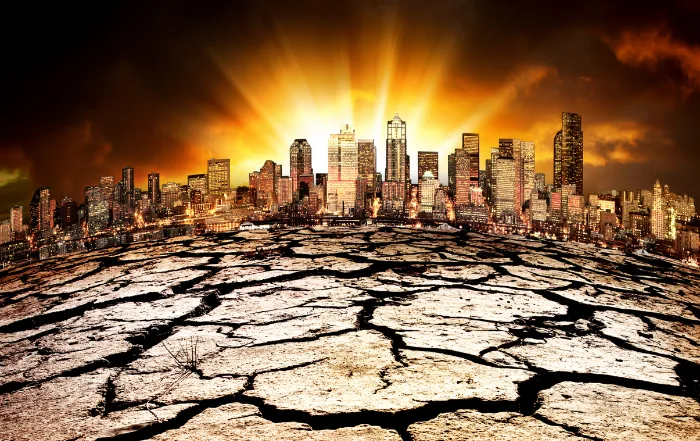Across the globe, ecosystems are undergoing dramatic transformations. Rainforests are giving way to farmland, savannas are drying up and turning into deserts, and the icy tundra is thawing.
Alarming scientific studies have identified over 20 instances of “regime shifts,” where tipping points have been crossed, leading to irreversible changes in various ecosystems. Shockingly, more than 20% of ecosystems worldwide are at risk of shifting or collapsing into entirely different states.
What is even more concerning is that these collapses may happen sooner than anticipated. Human activities have placed ecosystems under significant pressure, causing various forms of stress. When these stresses combine with the amplified impacts of climate-driven extreme weather events, the crossing of tipping points could be accelerated by up to 80%.
The findings of the latest research, published in Nature Sustainability, paint a bleak picture. An ecosystem collapse that was previously expected to occur later this century could now transpire within the next few decades. In this article, we delve into the reasons behind these collapses and explore the potential catastrophic consequences they may bring.
Understanding the Pressures on Ecosystems
The growth of the human population, escalating economic demands, and the rising concentration of greenhouse gases all exert immense pressures on ecosystems and landscapes. These pressures are driven by the need for food and the preservation of critical services, such as clean water. Additionally, the frequency and intensity of extreme climate events are increasing, further exacerbating the situation.
The Threat of Ecological Doom-loops
Of particular concern is the possibility that climate extremes could strike ecosystems that are already under stress. This creates a domino effect, transferring or intensifying stresses onto neighboring ecosystems and triggering successive feedback loops.
These ecological doom-loops, as the researchers termed them, pose a grave threat and can lead to catastrophic consequences.
Determining the Point of Collapse
Recent research that sought to understand the threshold at which ecosystems collapse under stress used computer models that simulate how ecosystems function and respond to changing circumstances.
This study utilized two general ecological models representing forests and lake water quality, as well as location-specific models for the Chilika lagoon fishery in India and Easter Island in the Pacific Ocean. The latter models incorporated interactions between human activities and the natural environment.

A crucial aspect of these models is the inclusion of feedback mechanisms that help maintain balance and stability within the ecosystem when stresses are manageable.
For example, in Lake Chilika, fishers tend to target adult fish while their numbers are abundant, ensuring stability as long as sufficient adults are left for breeding. However, when stresses surpass the capacity to absorb them, the ecosystem reaches a point of no return—a tipping point—and collapses.
In the case of Chilika, this collapse might occur when fishers resort to catching juvenile fish during shortages, further compromising the replenishment of the fish stock.
Accelerated Collapse
By running over 70,000 simulations, the researchers observed that the combination of stress and extreme events brought forward the predicted tipping points by anywhere from 30% to 80% across all four models.
Consequently, an ecosystem forecasted to collapse in the 2090s due to gradual stressors, such as rising global temperatures, could potentially collapse as early as the 2030s when factoring in additional issues like extreme rainfall, pollution, or sudden spikes in resource utilization.
Of significant importance is the discovery that approximately 15% of ecosystem collapses in our simulations occurred due to new stresses or extreme events, even when the primary stress level was kept constant. This implies that even if we believe we are sustainably managing ecosystems by maintaining stable stress levels—such as regulating fish catches—we must remain vigilant for new stresses and extreme events that can disrupt the delicate balance.
No Bailouts for Ecosystems
Prior studies have warned of substantial costs associated with crossing tipping points in large ecosystems, anticipated to materialize in the latter half of this century.
However, the research suggests that these costs may manifest much earlier. The speed at which stress is applied plays a vital role in understanding ecosystem collapse—a concept that likely extends beyond ecological systems.
The accelerated pace of news coverage and digital banking processes has been cited as factors that increase the risk of financial collapse.
Here, though, the comparison between ecological and economic systems diverges.
Banks can be salvaged if governments provide sufficient financial capital through bailouts.
Conversely, no government can provide the immediate natural capital required to restore a collapsed ecosystem.
There are no ecological bailouts. In financial terms, we must accept the full extent of the consequences.
Conclusion
The impending collapse of ecosystems presents a grave threat to our planet. The accelerated crossing of tipping points, driven by human-induced stresses and climate extremes, could lead to irreversible ecological doom-loops with far-reaching impacts.
This research underscores the urgency to address these issues and adopt sustainable practices to mitigate the pressures on ecosystems. The fate of collapsing ecosystems serves as a stark reminder that once lost, the natural capital they provide cannot be restored. It is imperative that we act now to protect and preserve the delicate balance of our planet’s ecosystems for generations to come.



















